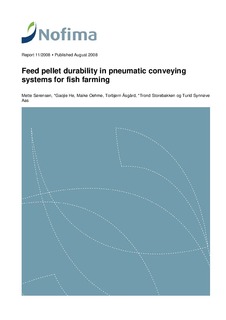| dc.description.abstract | This report is based on Gaojie He’s master thesis, which was completed in june 2008 at the Department of Animal and Aquacultural Sciences, Norwegian University of Life Sciences, supervised by Mette Sørensen and Trond Storebakken. The degradation of three commercial diets (denoted A, B and C) during pneumatic conveying at different air speeds and feeding rates was investigated in the present experiment. The experiment was arranged in a three by three by three factorial design, with physical quality (Doris value of feed A, B and C was 30.6, 23.7 and 16.5, respectively), airspeed (25, 39 and 35 m/s) and feeding rate (9, 18 and 36 kg/min). Degradation during pneumatic transportation was investigated using the research facilities of a company producing computer-controlled pneumatic feeding systems (AkvaMarina CCS Feed System, Akvasmart, AKVA group, Bryne, Norway). Feed samples of 2 kg were pneumatically conveyed through a 400 m pipeline. The samples were collected at the outlet of the pipeline and sieved in order to determine total degradation as well as amount of fractures and dust. Durability and hardness of the pellets were also evaluated by use of Ligno tester and texture analyzer. The results showed that degradation of pellets during pneumatic conveying was affected by physical quality of feed, airspeed and feeding rate. All three different diets showed different degradation patterns during pneumatic conveying. Pneumatic conveying of feed A showed the least degradation, generating the lowest amount of small particles. Feed B was ranked in between feed A and feed C in terms of degradation, but generated a relatively high amount of dust (particle size < 2.36 mm). Feed C showed the highest degradation during pneumatic conveying, and formed a higher amount of fracture (particle size 2.36-10 mm) than dust. The formation of dust and fracture during the pneumatic conveying did not significantly correlate to the Doris value. Feed A had the highest Doris value and feed B the lowest. As airspeed increased, the generations of both fractures and dust were increased. Increasing the feeding rate had the opposite effect, causing a reduction in formation of dust and fracture. The overall conclusion from the experiment was that the three diets varied in degradation pattern during pneumatic transportation. No good correlation was found between Doris, hardness, durability index or bulk density and degradation during pneumatic conveying, but in general, degradation of pellets increased as airspeed increased, whereas high feeding rate appeared to protect the pellets from degradation. | |
